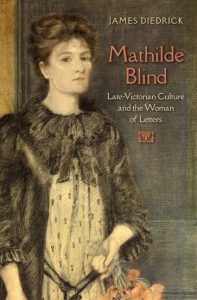Diana Maltz, whose book British Aestheticism and the Urban Working Classes, 1870-1900: Beauty for the People helped inform my thinking as I wrote my biography, has just reviewed Mathilde Blind: Late-Victorian Culture and the Woman of Letters for Victorian Studies (vol. 61, no. 1, 2018, pp. 145–147). Every writer dreams of reviews like this one–attuned to the author’s aims and attentive to the nuance of the argument. I especially appreciate Maltz’s emphasis on the ways Mathilde Blind’s career and writing speak to the current state of play in Victorian scholarship and criticism:
One would be hard-pressed to find a sharper embodiment of late-Victorian cosmopolitanism than editor, fiction writer, critic, biographer, translator, and poet Mathilde Blind. The expatriate German-Jewish Blind was at the matrix of aesthetic, socialist, free-thinking, and New Woman circles throughout her literary career. James Diedrick’s biography, Mathilde Blind: Late-Victorian Culture and the Woman of Letters, offers a chronological study of Blind’s growing intellectual interests and social networks as well as analyses of her key works in their contexts. As such, this is a boon to scholars researching Blind, and a profound contribution to Victorian studies. (145)
Maltz also notes the importance of literary networks in encouraging, sustaining and extending Blind’s career and influence:
The aesthetic coterie around the Dark Blue was just one early manifestation of Blind’s sustained interdependent literary community. Authors recommended one another to publishers, read each other’s work in draft and aloud to fellow writers, and reviewed each other’s volumes. Just as Blind helped coax James Thomson’s The City of Dreadful Night (1874) toward publication, she in turn sought Thomson’s aid in finding a publisher for her antitheistic poem “The Prophecy of St. Oran” (1881). Arthur Symons also benefited from Blind’s contacts and promoted her work in kind, though he could be condescending about it. Into the fin de siècle, Blind forged alliances with New Women. [147] Friendships with sexual nonconformists such as Vernon Lee encouraged a new ambiguity in her poems, where speakers’ genders are unclear and their affections potentially queer. Diedrick locates a similarly subtle same-sex eroticism in a journal entry about Mona Caird during their holiday together in 1893. (146-37)
I also value the way Maltz succinctly conveys how Blind’s gender radicalism informed all of her writing, from her essays and translations to her poetry:
Writing on Mary Wollstonecraft, she emphasized the radical potential of women’s education by imagining an expansion of women’s professions. Translating the diary of the late Marie Bashkirtseff, Blind strategically described Bashkirtseff’s suffocation in the skin, or “envelope,” of her gender (208). Diedrick similarly underscores the feminist purport of Blind’s creative writings, such as her revisionist invention of Mona in “The Prophecy of St. Oran,” her enthroning of a primeval mythical mother figure in Birds of Passage’s “Nuit” (1895), her psychological explorations of sexual exploitation and infidelity in Dramas in Miniature (1891), and her critiques of marriage in Tarantella (1885) and The Ascent of Man (1889).
Finally, I thank Professor Maltz for emphasizing my close readings of Blind’s work and the ways in which they are in dialogue with late-Victorian cultural discourse:
He performs nuanced close readings of primary texts and situates them in wider cultural conversations, as when he shows The Ascent of Man as a reflection of evolutionary writings by Blind’s friend William Kingdon Clifford and as a response to heated debates on the Woman Question. This methodology impelled Diedrick to go beyond archival research on Blind to read the political, theological, and philosophical texts that inspired her. The result is a comprehensive, layered study of interest to scholars of Victorian poetry, periodical studies, gender and women’s studies, and aestheticism and decadence. (147)
Victorian Studies is published by Indiana University. For more information about the journal and the press, visit their website.
